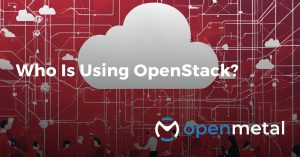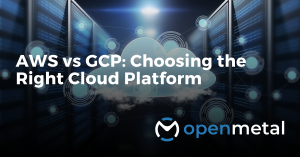Virtual Private Clouds (VPCs) are fundamental building blocks to users deploying workloads in public cloud environments. A VPC is a secure, isolated private cloud hosted within a public cloud. VPC resources can be isolated from the public internet, providing security, control, and flexibility that modern enterprises need for their cloud infrastructure. However, they are still hosted on shared hardware.
OpenStack projects give organizations a compelling alternative to traditional public cloud VPCs. They provide similar features with better control and predictable costs.
This technical analysis will demonstrate how OpenStack projects can be used much like VPC within a public cloud VPC.
What is a VPC?
A Virtual Private Cloud creates a private segment of public cloud with its own private network. It’s a secure, isolated space where you can store your data, run your applications, and manage your online resources. This smart cloud networking approach lets businesses maintain full control of their network’s layout while taking advantage of the public cloud’s scalable resources.
The virtual network resembles traditional on-premises infrastructure and provides better security through network isolation without incurring the high costs associated with on-prem.
Core VPC Features
There are several key components that make up a VPC. These include:
- Virtual Network: VPC creates a logically isolated virtual network withing your cloud provider’s infrastructure. These segments can be further divided into subnets which allow you to organize resources.
- IP Address Range: With a VPC you have control over the IP address range assigned to your VPC and subnets so you can plan your network addressing scheme.
- Route Tables: Route tables define how traffic is routed within your VPC. Custom route tables can be used to control the flow of traffic and implement security policies.
- Network Gateways: You can use network gateways to facilitate communication between your VPC and the internet or other networks. With a private network, you will need a way to access your VPC. You can use internet gateways to access your VPC.
- Network Access Control Lists (ACLs): Protect subnet boundaries.
- Security Groups: Function like firewalls for your VMs which allow you to control inbound and outbound traffic, protecting your instances from unauthorized access.
Common VPC Implementations Across Major Cloud Providers
Feature | AWS VPC | Google Cloud VPC | Azure VNet |
Network Scope | Regional | Global | Regional |
| Default Firewall | Security Groups & NACLs | Distributed Firewall | Network Security Groups |
| Private Connectivity | VPC Peering, PrivateLink | VPC Network Peering | VNet Peering |
| Cloud Integration | Native AWS Services | Google Cloud Services | Azure Services |
How To Create A VPC On OpenStack?
With a private OpenStack cloud, you can create Project-Based VPC which can create a segment of a cloud with predefined resources that you can use to create VMs, allocate storage, and most of the other functionalities of a VPC.
What Is A Project On OpenStack?
When you think of OpenStack projects, the first thing that usually comes to mind is one of the software components. After all, OpenStack clouds are built with a collections of projects, each of which is responsible for a different function within the cloud. This confusion may be the reason why lately they are more commonly referred to as services.
OpenStack projects, for the purpose of this blog, is a collection of resources grouped together and isolated within the OpenStack cloud by the user. It’s best practice to assign cloud resources in projects to isolated work environments of different teams.
When Should I Use Project-Based VPC?
A project-based VPC is best for small-scale environments with limited isolation needs and centralized management teams. If you have a small cloud where the network and security configurations are managed by a single admin team, the project based VPC approach keeps your resources centralized and easy to monitor.
How To Create A Project On OpenStack?
This guide will walk you through the process to create projects and users assigned to those projects on OpenMetal’s OpenStack Private Clouds.
VPC Feature Comparison
| VPC Feature | Public Cloud VPC | Project-Based VPC (OpenStack) |
|---|---|---|
| VPC | Isolated Network Environment | Project |
| Subnet | Subnet | Networks |
| DHCP Options | DHCP Options | IPAM |
| Elastic IP | Elastic IP | Floating IP |
| Network ACLs | Network ACLs | Network ACLs |
| Security Groups | Security Groups | Security Groups |
| Route Table | Route Table | Route Table |
Learn More About On-Demand Private Cloud Powered by OpenStack
More From OpenMetal…

It may be surprising to see large scale use cases such as Walmart or China Mobile, or use cases in organizations like NASA who have stringent security regulations, but the ability of organizations to fine tune and customize OpenStack in the code makes it the ideal infrastructure software for organizations with the skills on hand . …. Read More

Explore alternatives to OpenStack – Apache CloudStack, VMware vCloud, Proxmox, Google Cloud Platform and Amazon Web Services. OpenStack is an open source platform composed of several independent components. These components interoperate with each other through Application Programming Interface (API)…. Read More

AWS vs GCP: Choosing The Right Cloud Platform
AWS and GCP are leading players in cloud computing, offering a wide range of services and attractive pricing. However, choosing the right platform requires understanding their strengths, customer pain points, and alternatives. Comparing and shopping around for cloud products can be complex … Read More
Test Drive
For eligible organizations, individuals, and Open Source Partners, Private Cloud Cores are free to trial. Apply today to qualify.
Subscribe
Join our community! Subscribe to our newsletter to get the latest company news, product releases, updates from partners, and more.



































